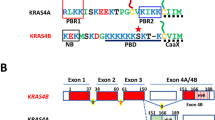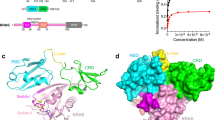Abstract
Ras proteins are proto-oncogenes that function as molecular switches linking extracellular stimuli with an overlapping but distinctive range of biological outcomes. Although modulatable interactions between the membrane and the Ras C-terminal hypervariable region (HVR) harbouring the membrane anchor motifs enable signalling specificity to be determined by their location, it is becoming clear that the spatial orientation of different Ras proteins is also crucial for their functions. To reveal the orientation of the G-domain at membranes, we conducted an extensive study on different Ras isoforms anchored to model raft membranes. The results show that the G-domain mediates the Ras–membrane interaction by inducing different sets of preferred orientations in the active and inactive states with largely parallel orientation relative to the membrane of most of the helices. The distinct locations of the different isoforms, exposing them to different effectors and regulators, coupled with different G-domain-membrane orientation, suggests synergy between this type of recognition motif and the specificity conferred by the HVR, thereby validating the concept of isoform specificity in Ras.







Similar content being viewed by others
Abbreviations
- aa:
-
Amino acid
- AFM:
-
Atomic-force microscopy
- ATR-FTIR:
-
Attenuated total-reflection Fourier-transform infrared
- DMPC:
-
1,2-Dimyristoyl-sn-glycero-3-phosphocholine
- DOPC:
-
1,2-Dioleoyl-sn-glycero-3-phosphocholine
- DOPG:
-
1,2-Dioleoyl-sn-glycero-3-phospho-(1′-rac-glycerol)
- DPPC:
-
1,2-Dipalmitoyl-sn-glycero-3-phosphocholine
- DPPG:
-
1,2-Dipalmitoyl-sn-glycero-3-phospho-(1′-rac-glycerol)
- HVR:
-
Hypervariable region
- IRRAS:
-
Infrared reflection absorption spectroscopy
- ld :
-
Liquid-disordered
- lo :
-
Liquid-ordered
- MD:
-
Molecular dynamics
- PM:
-
Plasma membrane
References
Abankwa D, Gorfe AA, Hancock JF (2008a) Mechanisms of Ras membrane organization and signalling: Ras on a rocker. Cell Cycle 7:2667–2673
Abankwa D, Hanzal-Bayer M, Ariotti N, Plowman SJ, Gorfe AA, Parton RG, McCammon JA, Hancock JF (2008b) A novel switch region regulates H-Ras membrane orientation and signal output. EMBO J 27:727–735
Abankwa D, Gorfe AA, Inder K, Hancock JF (2010) Ras membrane orientation and nanodomain localization generate isoform diversity. Proc Natl Acad Sci USA 107:1130–1135
Ausili A, Corbalan-Garcia S, Gomez-Fernandez JC, Marsh D (2011) Membrane docking of the C2 domain from protein kinase C alpha as seen by polarized ATR-IR. The role of PIP2. Biochim Biophys Acta Biomembr 1808:684–695
Axelsen PH, Citra MJ (1996) Orientational order determination by internal reflection infrared spectroscopy. Prog Biophys Mol Biol 66:227–253
Bechinger B, Ruysschaert JM, Goormaghtigh E (1999) Membrane helix orientation from linear dichroism of infrared attenuated total reflection spectra. Biophys J 76:552–563
Bos JL (1989) Ras oncogenes in human cancer—a review. Cancer Res 49:4682–4689
Bringezu F, Majerowicz M, Wen SY, Reuther G, Tan KT, Kuhlmann J, Waldmann H, Huster D (2007) Membrane binding of a lipidated N-Ras protein studied in lipid monolayers. Eur Biophys J 36:491–498
Brunsveld L, Kuhlmann J, Alexandrov K, Wittinghofer A, Goody RS, Waldmann H (2006) Lipidated Ras and Rab peptides and proteins—synthesis, structure, and function. Angew Chem Int Edit 45:6622–6646
Brunsveld L, Waldmann H, Huster D (2009) Membrane binding of lipidated Ras peptides and proteins: the structural point of view. Biochim Biophys Acta Biomembr 1788:273–288
Chen YX, Koch S, Uhlenbrock K, Weise K, Das D, Gremer L, Brunsveld L, Wittinghofer A, Winter R, Triola G, Waldmann H (2010) Synthesis of the Rheb and K-Ras4B GTPases. Angew Chem Int Edit 49:6090–6095
Evers F, Jeworrek C, Weise K, Tolan M, Winter R (2012) Detection of lipid raft domains in neutral and anionic Langmuir monolayers and bilayers of complex lipid composition. Soft Matter 8:2170–2175
Goormaghtigh E, Raussens V, Ruysschaert JM (1999) Attenuated total reflection infrared spectroscopy of proteins and lipids in biological membranes. Biochim Biophys Acta Rev Biomembr 1422:105–185
Gorfe AA, Babakhani A, McCammon JA (2007a) H-Ras protein in a bilayer: interaction and structure perturbation. J Am Chem Soc 129:12280–12286
Gorfe AA, Hanzal-Bayer M, Abankwa D, Hancock JF, McCammon JA (2007b) Structure and dynamics of the full-length lipid-modified H-Ras protein in a 1,2-dimyristoylglycero-3-phosphocholine bilayer. J Med Chem 50:674–684
Güldenhaupt J, Adiguzel Y, Kuhlmann J, Waldmann H, Kotting C, Gerwert K (2008) Secondary structure of lipidated Ras bound to a lipid bilayer. FEBS J 275:5910–5918
Hancock JF (2003) Ras proteins: different signals from different locations. Nat Rev Mol Cell Biol 4:373–384
Hancock JF, Parton RG (2005) Ras plasma membrane signalling platforms. Biochem J 389:1–11
Hancock JF, Paterson H, Marshall CJ (1990) A Polybasic domain or palmitoylation is required in addition to the Caax motif to localize p21 Ras to the plasma membrane. Cell 63:133–139
Hancock JF, Cadwallader K, Marshall CJ (1991) Methylation and proteolysis are essential for efficient membrane binding of prenylated p21 K-Ras(B). EMBO J 10:641–646
Harrick NJ (1967) Internal reflection spectroscopy. Interscience, New York
Huster D, Kuhn K, Kadereit D, Waldmann H, Arnold K (2001) H-1 high-resolution magic angle spinning NMR spectroscopy for the investigation of a Ras lipopeptide in a lipid membrane. Angew Chem Int Edit 40:1056–1058
Kapoor S, Werkmüller A, Denter C, Zhai Y, Markgraf J, Weise K, Opitz N, Winter R (2011) Temperature-pressure phase diagram of a heterogeneous anionic model biomembrane system: results from a combined calorimetry, spectroscopy and microscopy study. Biochim Biophys Acta Biomembr 1808:1187–1195
Kapoor S, Triola G, Vetter IR, Erlkamp M, Waldmann H, Winter R (2012) Revealing conformational substates of lipidated N-Ras protein by pressure modulation. Proc Natl Acad Sci USA 109:460–465
Karnoub AE, Weinberg RA (2008) Ras oncogenes: split personalities. Nat Rev Mol Cell Biol 9:517–531
Kuhn K, Owen DJ, Bader B, Wittinghofer A, Kuhlmann J, Waldmann H (2001) Synthesis of functional Ras lipoproteins and fluorescent derivatives. J Am Chem Soc 123:1023–1035
Lewis RN, McElhaney RN (1992) Structures of the subgel phases of n-saturated diacyl phosphatidylcholine bilayers: FTIR spectroscopic studies of 13C=O and 2H labeled lipids. Biophys J 61:63–77
Lukman S, Grant BJ, Gorfe AA, Grant GH, McCammon JA (2010) The distinct conformational dynamics of K-Ras and H-Ras A59G. PLoS Comput Biol 6:e1000922
Marsh D (1999) Quantitation of secondary structure in ATR infrared spectroscopy. Biophys J 77:2630–2637
Meister A, Nicolini C, Waldmann H, Kuhlmann J, Kerth A, Winter R, Blume A (2006) Insertion of lipidated Ras proteins into lipid monolayers studied by infrared reflection absorption spectroscopy (IRRAS). Biophys J 91:1388–1401
Mendelsohn R, Mao GR, Flach CR (2010) Infrared reflection-absorption spectroscopy: principles and applications to lipid–protein interaction in Langmuir films. Biochim Biophys Acta Biomembr 1798:788–800
Nagele E, Schelhaas M, Kuder N, Waldmann H (1998) Chemoenzymatic synthesis of N-Ras lipopeptides. J Am Chem Soc 120:6889–6902
Papahadjopoulos D, Vail WJ, Pangborn WA, Poste G (1976) Studies on membrane-fusion. 2. Induction of fusion in pure phospholipid membranes by calcium ions and other divalent metals. Biochim Biophys Acta 448:265–283
Prior IA, Muncke C, Parton RG, Hancock JF (2003) Direct visualization of Ras proteins in spatially distinct cell surface microdomains. J Cell Biol 160:165–170
Schubbert S, Bollag G, Shannon K (2007) Deregulated Ras signalling in developmental disorders: new tricks for an old dog. Curr Opin Genet Dev 17:15–22
Simons K, Toomre D (2000) Lipid rafts and signal transduction. Nat Rev Mol Cell Biol 1:31–39
Smith SO, Kustanovich I, Bhamidipati S, Salmon A, Hamilton JA (1992) Interfacial conformation of dipalmitoylglycerol and dipalmitoylphosphatidylcholine in phospholipid bilayers. Biochemistry 31:11660–11664
Tian TH, Harding A, Inder K, Plowman S, Parton RG, Hancock JF (2007) Plasma membrane nanoswitches generate high fidelity Ras signal transduction. Nat Cell Biol 9:905–960
Vogel A, Reuther G, Weise K, Triola G, Nikolaus J, Tan KT, Nowak C, Herrmann A, Waldmann H, Winter R, Huster D (2009) The lipid modifications of Ras that sense membrane environments and induce local enrichment. Angew Chem Int Edit 48:8784–8787
Waldmann V, Rabes HM (1996) What’s new in ras genes? Physiological role of ras genes in signal transduction and significance of ras gene activation in tumorigenesis. Pathol Res Pract 192:883–891
Walsh AB, Bar-Sagi D (2001) Differential activation of the pac pathway by Ha-Ras and K-Ras. J Biol Chem 276:15609–15615
Weise K, Triola G, Brunsveld L, Waldmann H, Winter R (2009) Influence of the lipidation motif on the partitioning and association of N-Ras in model membrane subdomains. J Am Chem Soc 131:1557–1564
Weise K, Kapoor S, Denter C, Nikolaus J, Opitz N, Koch S, Triola G, Herrmann A, Waldmann H, Winter R (2011) Membrane-mediated induction and sorting of K-Ras microdomain signalling platforms. J Am Chem Soc 133:880–887
Willumsen BM, Christensen A, Hubbert NL, Papageorge AG, Lowy DR (1984) The p21 Ras C-terminus is required for transformation and membrane association. Nature 310:583–586
Wittebort RJ, Schmidt CF, Griffin RG (1981) Solid-state C-13 nuclear magnetic-resonance of the lecithin gel to liquid-crystalline phase-transition. Biochemistry 20:4223–4228
Wittinghofer A, Pai EF (1991) The structure of Ras protein—a model for a universal molecular switch. Trends Biochem Sci 16:382–387
Wittinghofer A, Waldmann H (2000) Ras—a molecular switch involved in tumor formation. Angew Chem Int Edit 39:4193–4214
Yan J, Roy S, Apolloni A, Lane A, Hancock JF (1998) Ras isoforms vary in their ability to activate Raf-1 and phosphoinositide 3-kinase. J Biol Chem 273:24052–24056
Zhai Y, Okoro L, Cooper A, Winter R (2011) Applications of pressure perturbation calorimetry in biophysical studies. Biophys Chem 156:13–23
Acknowledgments
This research was supported by the Deutsche Forschungsgemeinschaft (DFG, SFB 642) and the International Max Planck Research School (IMPRS). We are grateful to Christine Nowak for technical assistance. Furthermore, we thank Dr Andreas Kerth, Dr Annette Meister, and Professor Alfred Blume (all Martin-Luther-Universität Halle-Wittenberg, Germany) and Dr Andrea Gohlke for their help in setting up the IRRAS measurements in our laboratory. Finally, RW wants to thank Professor Dr Peter Laggner, to whom this work is dedicated, for many stimulating discussions in various fields of membrane biophysics over the years.
Author information
Authors and Affiliations
Corresponding author
Additional information
Special Issue: Scattering techniques in biology—marking the contributions to the field of Peter Laggner, on the occasion of his 68th birthday.
Rights and permissions
About this article
Cite this article
Kapoor, S., Weise, K., Erlkamp, M. et al. The role of G-domain orientation and nucleotide state on the Ras isoform-specific membrane interaction. Eur Biophys J 41, 801–813 (2012). https://doi.org/10.1007/s00249-012-0841-5
Received:
Revised:
Accepted:
Published:
Issue Date:
DOI: https://doi.org/10.1007/s00249-012-0841-5




